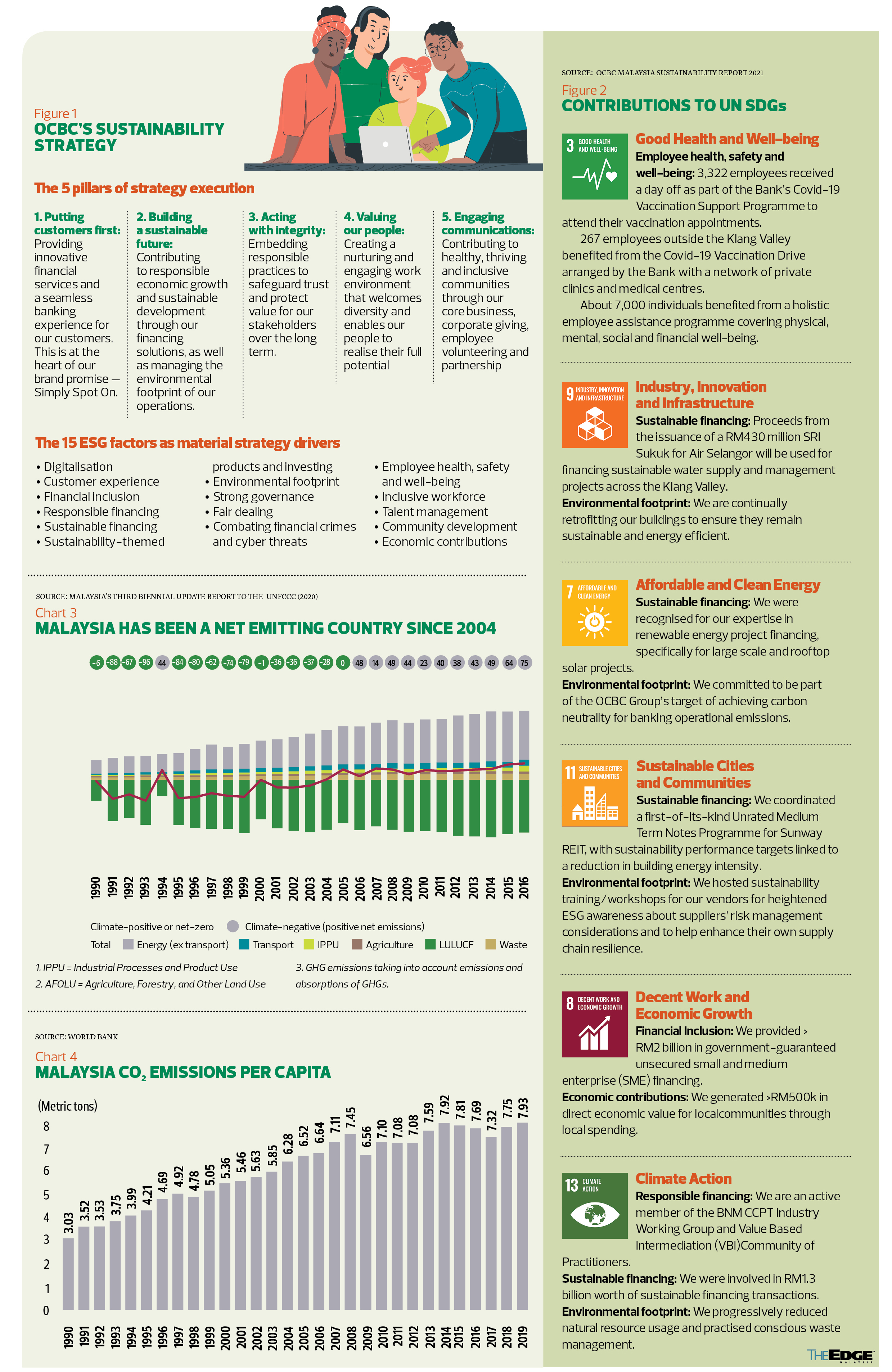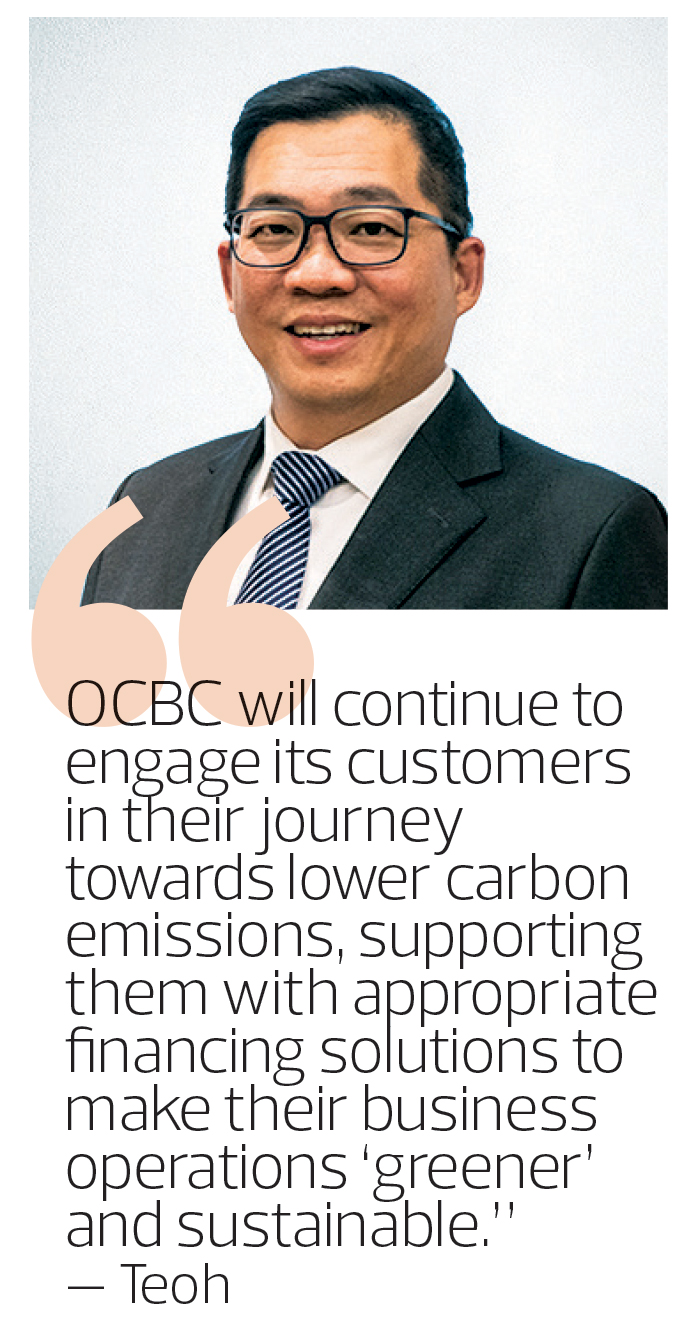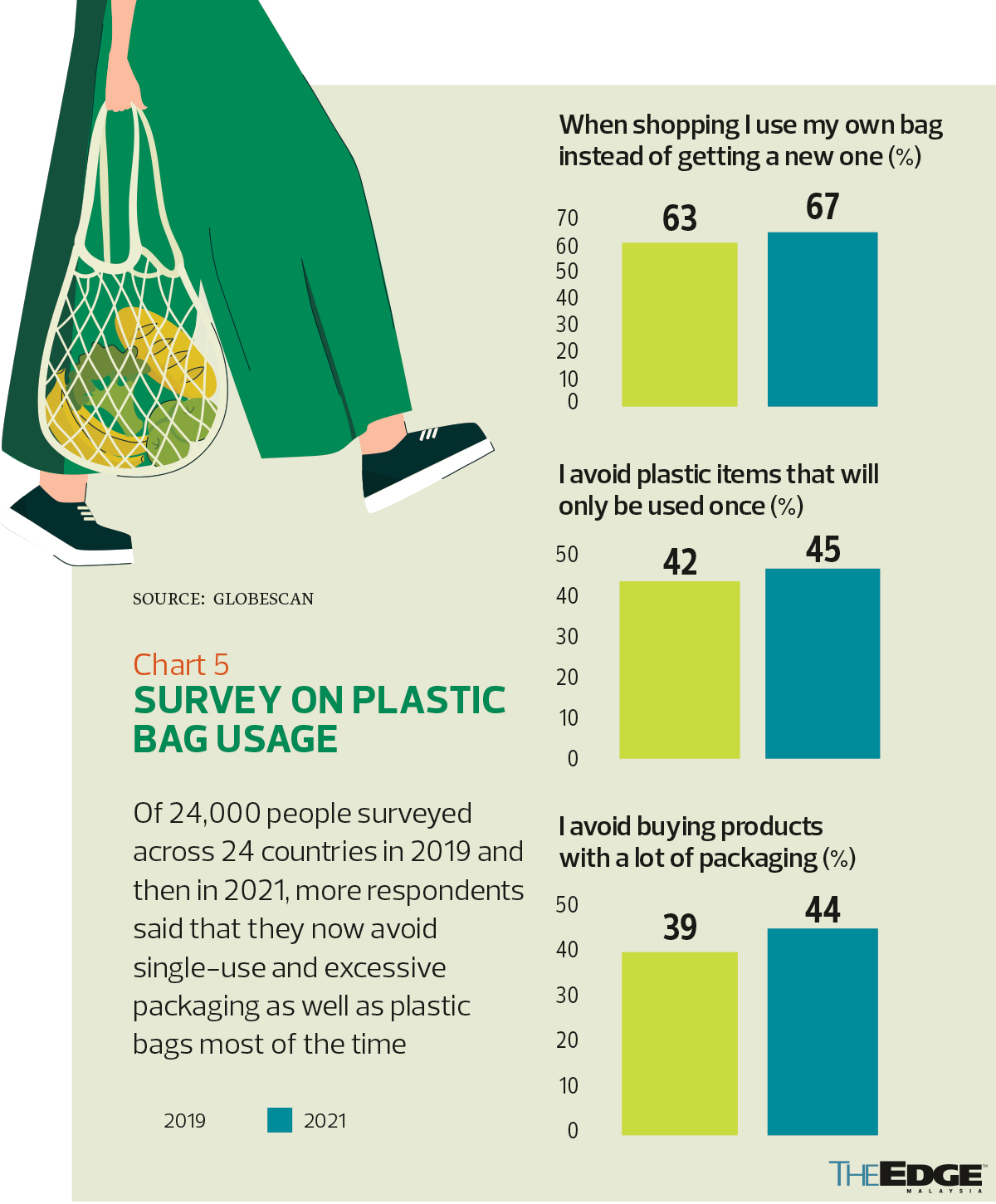
This article first appeared in The Edge Malaysia Weekly on December 12, 2022 - December 18, 2022
WITH governments’ climate policies and pledges falling short of limiting global warming at 1.5°C above pre-industrial levels, corporates are seen upping the ante in addressing this issue.
OCBC Bank, for one, has raised its sustainable financing target to S$50 billion by 2025, up from S$25 billion previously, as it had achieved S$34 billion at end-2021, surpassing its original target by a big margin.
Growth in sustainable financing is not showing signs of easing as well. For the nine months ended Sept 30, 2022, green and sustainable financing rose 45% from a year earlier to S$28 billion, making up 9% of the banking group’s loans.
OCBC Bank (Malaysia) Bhd managing director and head of corporate and commercial banking Jeffrey Teoh says the bank has put in place a comprehensive Sustainability Framework built upon five core pillars and 15 material environmental, social and governance (ESG) factors. “OCBC is committed to achieving carbon neutrality for our banking operational emissions in 2022,” he tells The Edge in an interview.
OCBC’s Sustainability Framework helps the bank set its strategic priorities and guides its approach in creating positive social and environmental impact through the management of the group’s 15 material ESG factors, says Teoh. “The framework also aligns our approach with the global sustainable development agenda of which we have identified six focus SDGs
(Sustainable Development Goals) where we believe we can make the greatest positive impact in the markets where we operate (see Figure 1).”
OCBC measures the performance of the five core pillars against selected United Nations SDGs, tracking the group’s long-term value creation for stakeholders. The SDGs provide a clear and shared global agenda for addressing the most pressing challenges facing society.
Teoh says achieving the SDGs will require investment in new solutions and working in partnership across the public sector, private sector and civil society. “OCBC focuses its efforts on six SDGs, where the bank can make the most meaningful difference (see Figure 2).”
It was exactly a year ago that Malaysia — or eight states in the peninsula to be more specific — experienced one of the worst floods in history. The calamity was just another sign of increasingly unpredictable weather conditions all over the world, no thanks to ongoing climate change caused by human-induced global warming.
This year, the disruptions from climate change are ever more apparent with pockets of flash floods being reported nationwide during this monsoon season, to the extent that the 15th general election process in Baram, Sarawak, had to be suspended.
It is worth noting that climate change is expected to have an impact on the lives and livelihoods of not only flood victims, but also everyone else. Rising sea levels in coastal areas, increased droughts, amplified heat waves in cities and loss of forests and oceanic ecosystems, on which we rely for essential food supply, can be seen across the world.
According to a report by WWF Malaysia and Boston Consulting Group (BCG) last year, current climate policies and pledges globally are falling short in terms of keeping global warming from exceeding 1.5°C above pre-industrial levels. The report, titled “Securing Our Future: Net Zero Pathways for Malaysia”, pointed out that steadily growing emissions from Malaysia has shifted the country from being a net negative to a net positive emissions country since 2004 (see Chart 3).”
Therefore, Teoh says it is vital for banks to assist small and medium enterprises (SMEs) in adopting ESG elements in their operations as the sector contributes 38.9% to the country’s GDP and employs 48.4% of the total workforce. “As SMEs continue to contribute significantly to the local economy, the transition will impact them in terms of competitiveness and affordability,” he adds.
Rising vulnerability to climate change
According to World Bank data, Malaysia’s carbon dioxide emissions per capita have been trending upwards since the 1990s. This is particularly worrying because the country is vulnerable to flooding (see Chart 4).”
The frequency and extremity of flood events have increased in recent decades, with scientists projecting more to come due to continued global warming. Meanwhile, the intensity of heat waves experienced in Malaysia is projected to increase significantly as well, due to a warmer climate.
In Malaysia, climate change is also expected to exacerbate poverty and inequality, with low-income earners economically dependent on activities where climate conditions play a prominent role, such as agriculture, fishing and informal sectors of the urban economy, who typically live in more exposed areas.
The WWF and BCG report found that 20% to 30% of Malaysia’s GDP is concentrated in high ESG risk sectors. So, it is critical for businesses to adopt sustainability measures to mitigate the adverse effects of climate change and to remain relevant in the future.
Teoh says SMEs that are able to adopt new business models and embrace ESG values will benefit from the sustained demand from customers for their goods and services. “These businesses could possibly even displace competitors that cannot keep up,” he points out.
Having said that, companies must plan their decarbonisation journey amid rising demand from investors and consumers for ESG practices to be incorporated into an organisation’s various functions and end products.
The world’s largest asset manager BlackRock, for example, voted against 255 board directors across various portfolio companies for failing to act on climate issues in the first half of 2021 alone.
A PwC Global investor survey in 2021 found that investors are paying more attention to ESG risks and opportunities facing the companies they invest in. Nearly 80% of the 325 respondents globally said ESG was an important factor in their investment decision-making, almost 70% thought ESG factors should be included in executive compensation targets and about 50% expressed a willingness to divest from companies that did not take sufficient action on ESG issues.
Meanwhile, a 2019-2021 study by consultancy firm Globescan shows that an increasing number of millennials and Gen Z consumers are driving the rise in demand for sustainable products. The study, covering 24,000 people across 24 countries, shows that consumers have begun to avoid single-use plastics in favour of a more sustainable lifestyle (see Chart 5).
On that note, Teoh says that although adopting ESG is critical for companies in their sustainability journey, many SMEs today still view ESG and profitability as conflicting goals. Hence, SMEs’ adoption of ESG policies and practices should be encouraged by tangible financial incentives and guided by appropriate sustainable financing packages.
“OCBC Bank, as a connector of capital, understands the importance of driving sustainable development in our society. The bank aims to support its customers with products and solutions that enable the transition to a low carbon and sustainable economy,” he adds.
Apart from investors and consumers, businesses are also facing regulatory demand for sustainability adoption in their corporate disclosures. Notably, it is mandatory for Bursa Malaysia-listed companies to disclose material economic, environmental and social risks and opportunities in their annual reports via the sustainability statement. In April 2022, Bank Negara Malaysia issued the Climate Change and Principle-based Taxonomy (CCPT) and established a CCPT Implementation Group to support its adoption by financial institutions.
Clearly, as the ESG agenda becomes one of the hottest topics in the market, companies adopting these practices may differentiate themselves meaningfully to facilitate the transition towards a low-carbon world. Hence, it is crucial for businesses to understand and measure their carbon footprint, and set out their sustainability commitment with a proper road map.
This would help in reducing their carbon footprint by increasing efficiency, procuring renewable energy, decarbonising the supply chain as well as adopting leading standards and frameworks on climate change and disclosures.
Teoh says the bank has developed the OCBC SME Sustainable Financing Framework, which makes it simpler and less costly for SMEs to access sustainable financing of up to RM60 million to accelerate their sustainability plans.
“SMEs can focus on growing their business sustainably instead of spending extra time and resources developing their own sustainable finance frameworks prior to application of green-labelled financing. The complexity and cost involved are additional burdens to SMEs,” he adds (see Figure 3).
Teoh says the unique role of the banking industry in supporting the transition to a more sustainable future is becoming ever more important. “OCBC will continue to engage its customers in their journey towards lower carbon emissions, supporting them with appropriate financing solutions to make their business operations ‘greener’ and sustainable.”
He adds that this is delivered through the group’s commitment to extend S$50 billion in sustainable financing by 2025.
Save by subscribing to us for your print and/or digital copy.
P/S: The Edge is also available on Apple's App Store and Android's Google Play.
- Reeves says UK to cut 10,000 civil service jobs ahead of key speech
- Sinopec's 2024 net profit plunges 16.8% due to falling oil prices, NEVs
- Trump says efforts to contain war in Ukraine ‘under control’
- Israeli airstrike kills Hamas official as Gaza death toll passes 50,000
- Bits + Bytes: A Miscellany Of Technology




